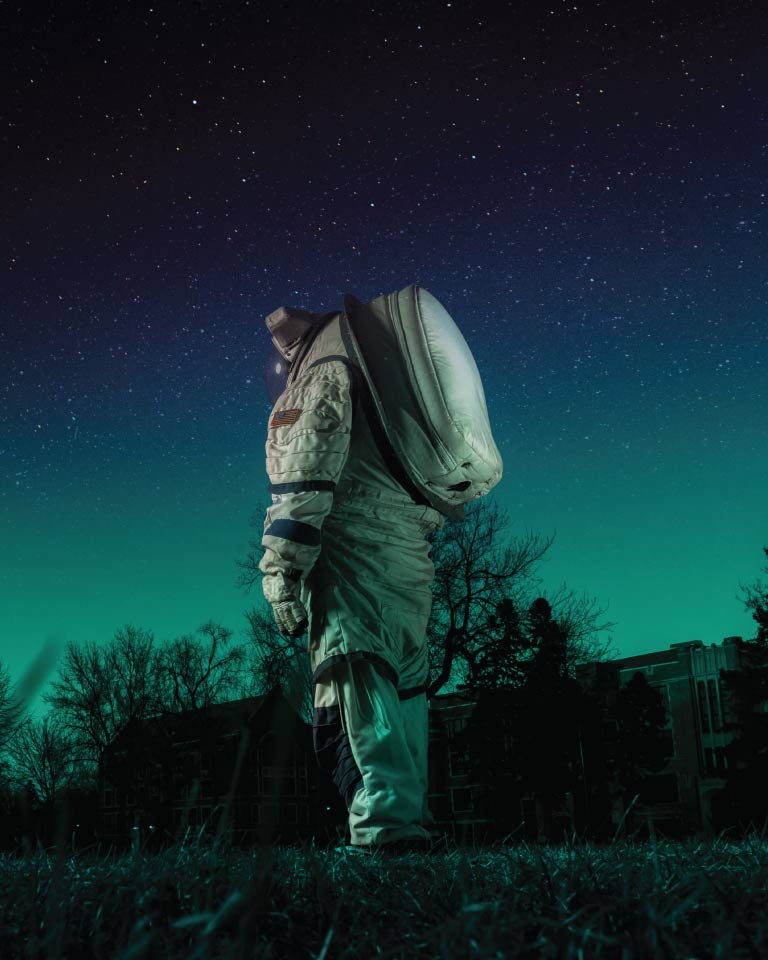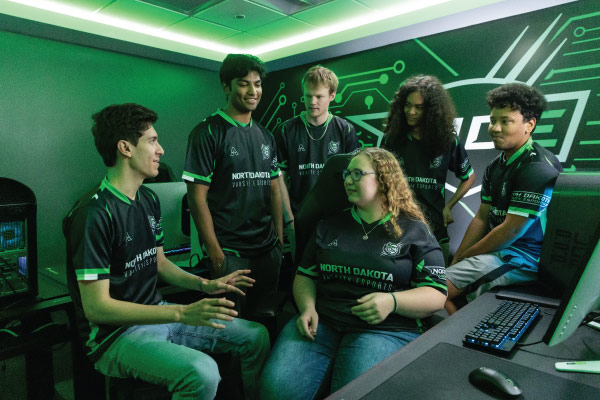Space Hub in the Heartland
UND is shaping how humans will explore, live, and work off-world.
Welcome to the John D. Odegard School of Aerospace Sciences — where UND’s Space Studies program is helping launch the next era of space exploration. From custom 3D-printed spacesuits to farming on asteroids, standout achievements are taking shape right here. Let’s take a tour.
First Stop: Spacesuit Lab
Developing Spacesuits for the ISS, Moon, and Mars
UND is the first university with a NASA-funded lab dedicated to designing and building spacesuits. Among the UND-designed spacesuits on display are computers, tools, and other equipment — including a 3D printer.
That’s what Dr. Pablo de León, Director of UND’s Space Studies program, used to make history. In 2024, he secured the first-ever patent for a 3D-printed spacesuit — a breakthrough that could change how astronauts gear up for deep-space missions.
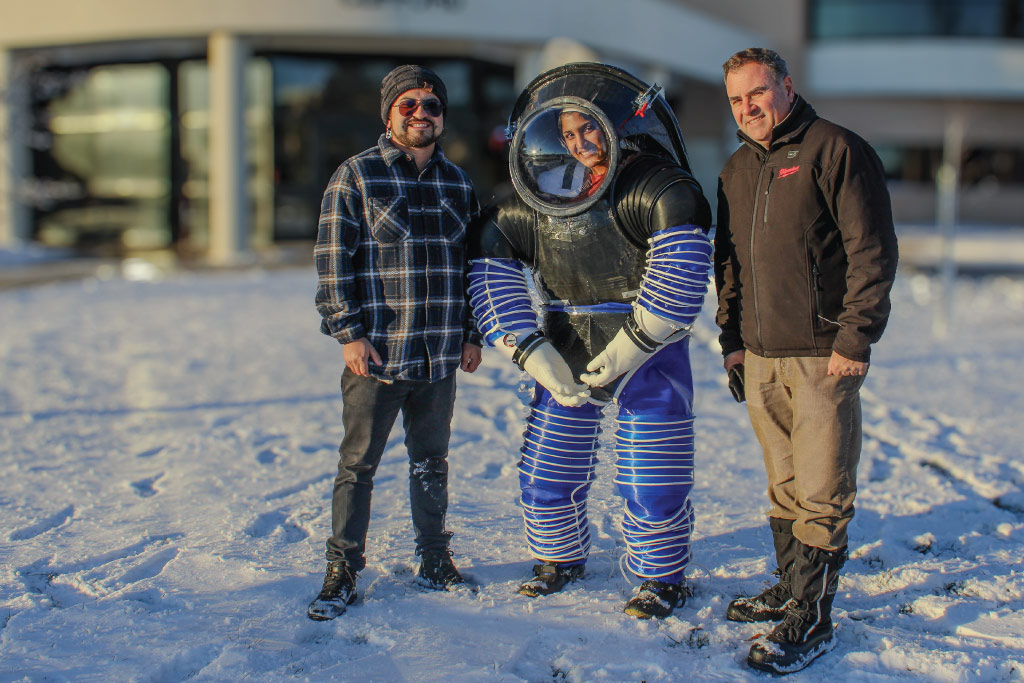
Pranika Gupta models a 3D-printed spacesuit with David Mateus, a graduate research assistant in the spacesuit lab, and Pablo de León.
Why 3D Printing Matters
NASA is preparing for longer lunar missions and more frequent, extended spacewalks. Over time, razor-sharp moondust wears down spacesuit fabrics. “Space is the most hostile environment imaginable. Astronauts face radiation, extreme temperatures, and a complete lack of oxygen,” Pablo said. “We need solutions that reduce dependence on Earth and make astronauts more self-sufficient and their missions more sustainable.”
With 3D printing, astronauts could manufacture and repair suit components on demand, right in space.
A Space Primer
A one-size-fits-all approach to spacesuit design doesn’t work because each space environment is different:
- On the International Space Station (ISS), astronauts float. Their suits lock their boots in place to stabilize them while they work with their arms.
- On the Moon, gravity is one-sixth of Earth’s; astronauts rely on their legs for mobility — kneeling, digging trenches, and navigating across jagged regolith dust that can damage suit fabric.
- On Mars, where gravity is one-third of Earth’s, bulky suits pose a challenge. “Carrying 50 pounds on your back for eight hours a day isn’t feasible,” Pablo said.
Since astronauts first traveled to space, they’ve worn custom-made, hand-sewn suits — with a single suit costing about $22 million. As space travel expands, suits need to be more durable, adaptable, and easy to replace.
Spacesuits are miniature spacecraft shaped like humans and designed to keep astronauts alive.Pablo de León
Pablo’s Printable Idea
“One day, I had a thought,” Pablo said. “What if we could use a flexible plastic with the emerging 3D printers of the time? Instead of rigid materials, we could try printing gloves with flexible filaments.”
Today, it takes a highly skilled technician 2,000 hours to assemble a single custom glove — tailored to fit each astronaut’s hands. But over time, those gloves wear out.
With 3D body scanning and flexible filament printing, astronauts could print their own gloves — and eventually entire suits — on demand.
“This might be bad news for the highly skilled workers who make suits today,” Pablo said. “But assembling a full suit takes up to 100 people. You can’t bring 100 people to space. Automation is the answer, and this method appears to work.”
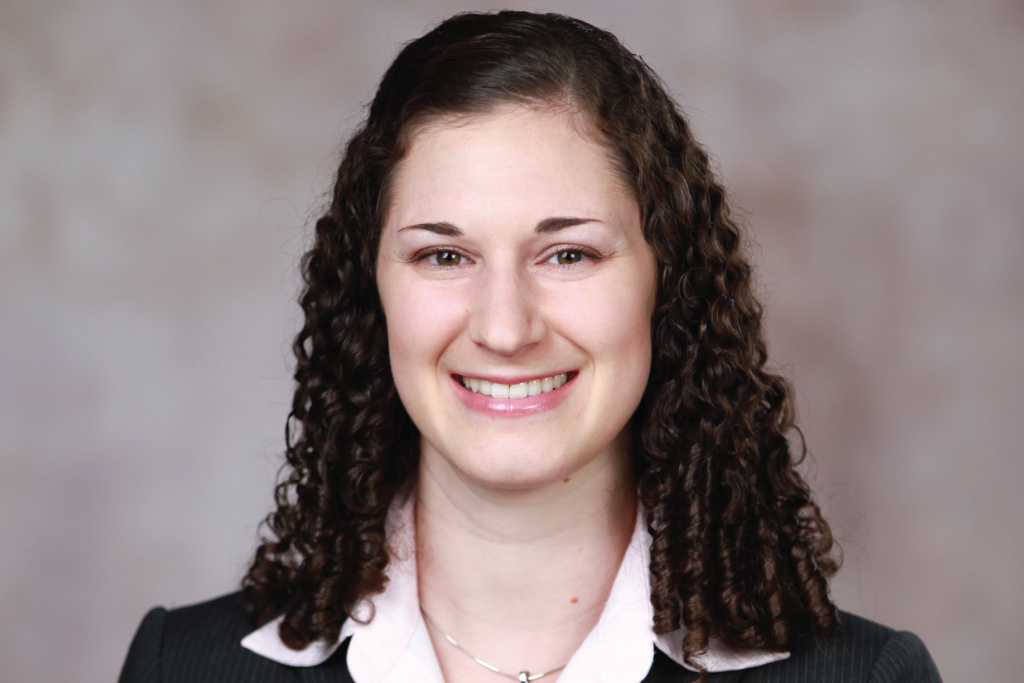
Kayla Daniels
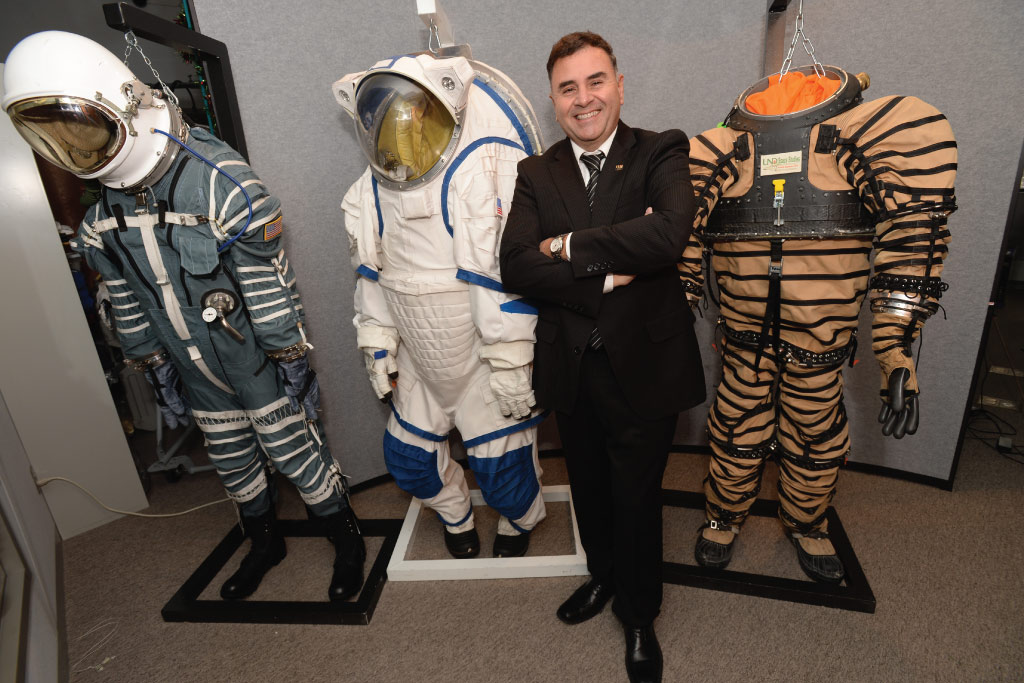
Pablo de León
Anatomy of a Spacesuit
Inside every spacesuit is a vital layer: the Liquid Cooling and Ventilation Garment (LCVG). It regulates body temperature by circulating chilled water through 300 feet of tubing while vents pull away sweat.
Kayla Daniels, ’22, focused her master’s thesis on improving that system using 3D printing. “Pablo pushed me to explore different aspects of space.” She served as a nutritionist for simulated crew missions inside UND’s Inflatable Lunar/Mars Analog Habitat (ILMAH). “He also kept me motivated — especially when my master’s thesis was rejected for the umpteenth time.”
Her perseverance paid off. While still a student, Kayla landed an internship at ILC Dover, NASA’s primary spacesuit supplier for over 50 years. “I became the subject matter expert for LCVG, which exposed me to all the other parts of the suit.”
Kayla now works in the Science & Space business unit of KBR, a global tech company supporting NASA. Based in Houston, she spends most of her time at Johnson Space Center collaborating with contractors and NASA teams.
“Several companies — KBR, SpaceX, Axiom, ILC Dover, and NASA — are working on the next generation of suits,” she said. “We’re making them better and more efficient.”
Spacesuits are critical for survival beyond Earth — but once astronauts step onto the Moon, they’ll need more than just durable suits. They’ll need the right footwear, too.
Second Stop: BiPed Lab
Designing Lunar Footwear
With NASA’s Artemis program preparing astronauts to return to the Moon, researchers at UND’s BiPed Lab are designing boots that will help them move better and safer in low gravity.
“In lunar gravity, you spend more time in the air,” said Rebecca Rhoades, ’24, UND instructor and Kinesiology field experience coordinator. “But once you hit the ground, your foot still moves the way it does on Earth to propel you forward.”
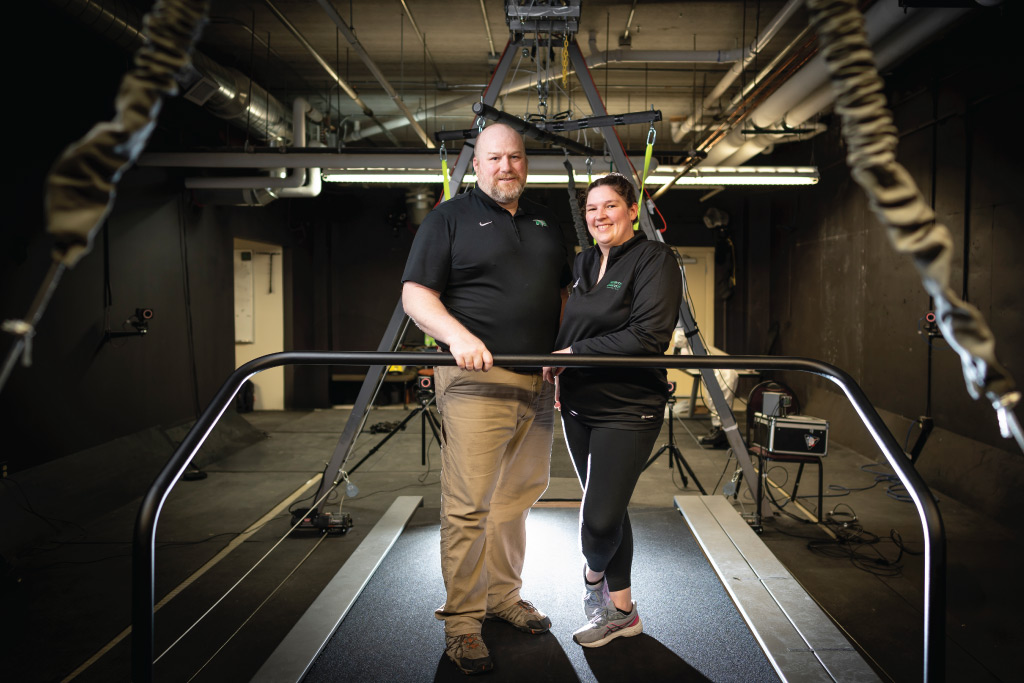
Jesse and Rebecca Roades work at the BiPed Lab, located in the Clinical Education Center near Ralph Engelstad Arena.
The Right Footing
Lunar boots contain rigid thermal plates to withstand extreme cold — but that stiffness disrupts natural foot movement. With astronauts expected to walk farther and work longer on future missions, the lack of flexibility increases risk of chronic injury.
Through a three-year NASA contract, UND is partnering with Cankdeska Cikana Community College (CCCC) in Fort Totten, North Dakota — led by instructors Nicholas Bitner and Mike Parker — to develop the next-generation Moon boot. The CCCC team designed the outsoles with help from UND’s Biomedical Engineering students and assistant professor Ryan Striker. UND leads the testing.
After a year of testing, two outsole designs emerged as the most effective: “Hoops,” shaped like concentric circles, and “Crabs,” which mimic crab legs.
Both are engineered to help counteract the stiffness of the boots and restore a more natural walking motion.
To test the designs, the team used a gravity simulator designed and built by Jesse Rhoades, Professor in Education, Health & Behavior Studies; Pablo, and Assistant Professor of Space Studies Keith Crisman. The system was constructed using rails, a trolley system, and an extra-wide treadmill. A gimbal suspends test subjects, allowing them to “walk” in simulated lunar gravity while motion-capture systems track their movements.
The concept was inspired by a NASA simulator called ARGOS, used at Johnson Space Center. Jesse’s version is far more affordable — and it delivers comparable data.
“That’s all homemade,” Jesse said. “We built almost all of the metalwork ourselves.”
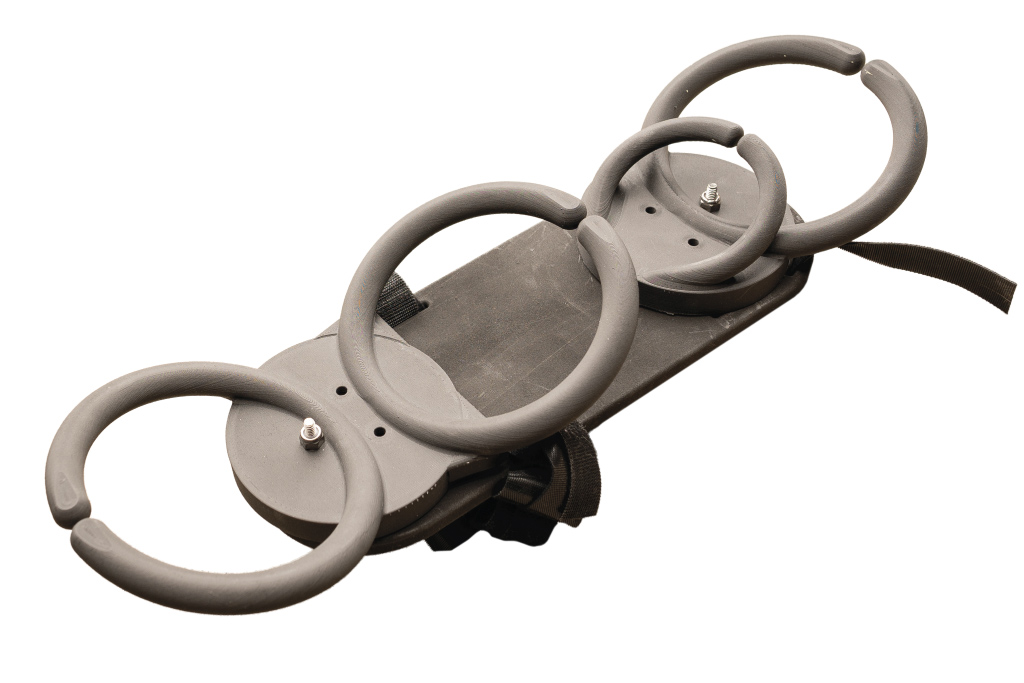
Boot outsole: Hoops
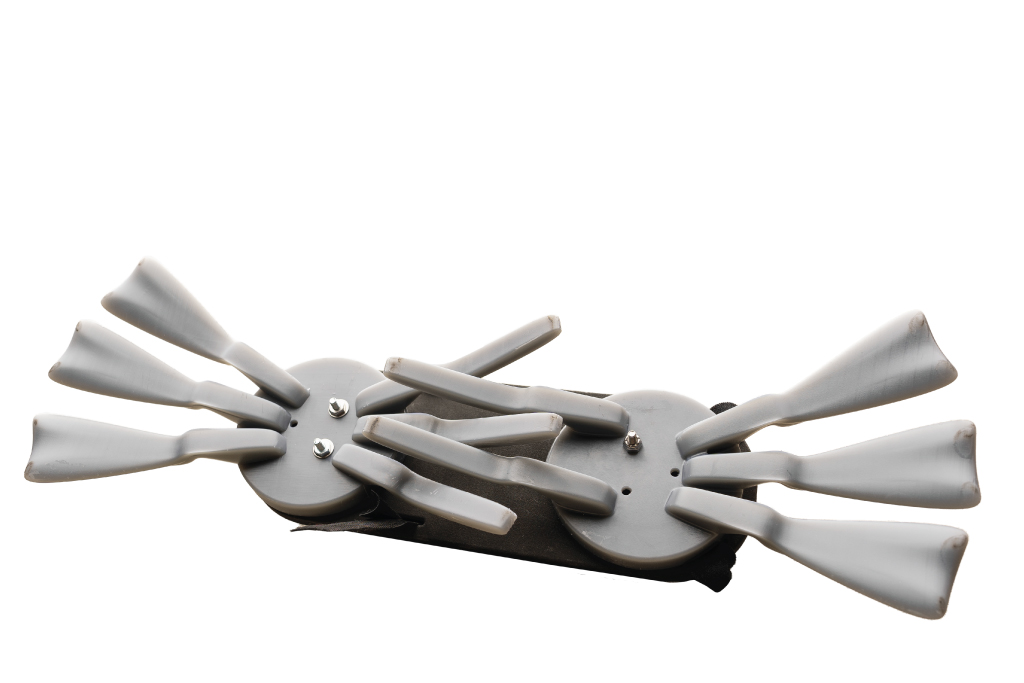
Boot outsole: Crabs
Facing Down Moondust
Walking isn’t the only challenge; the boots also need to stand up to lunar regolith, the ever-present, fine, clingy dust covering the Moon’s surface, which degrades boots and equipment over time.
The team tests for dust by bathing the boots in simulated moondust and measuring how much remains after cleaning.
Now in their second year of the project, they’re experimenting with different outsole materials like Kevlar, nylon, and other composites to determine which holds up best in harsh lunar conditions.
In the contract’s final year, the team will design a hands-free attachment system that lets astronauts step into the outsoles easily, “like stepping into skis,” Rebecca said.
Collaboration is Key
This project, like many at UND, thrives on collaboration. The team brings together Jesse, Pablo, and Keith Crisman, who specializes in risk mitigation and “human-in-the-loop” testing. As safety officer, Keith ensures participants are well-trained, briefed, and ready.
The same team also led one of the first U.S.-based studies on parastronauts. Their findings showed that astronauts with physical disabilities can perform just as effectively as their able-bodied counterparts in many modern space environments.
Their approach earned them UND’s Award for Interdisciplinary Collaboration in Research and Creative Activity.
“Our research wouldn’t be possible without the Space Studies program,” Jesse said.
“This entire lab was built on collaboration,” Rebecca added.
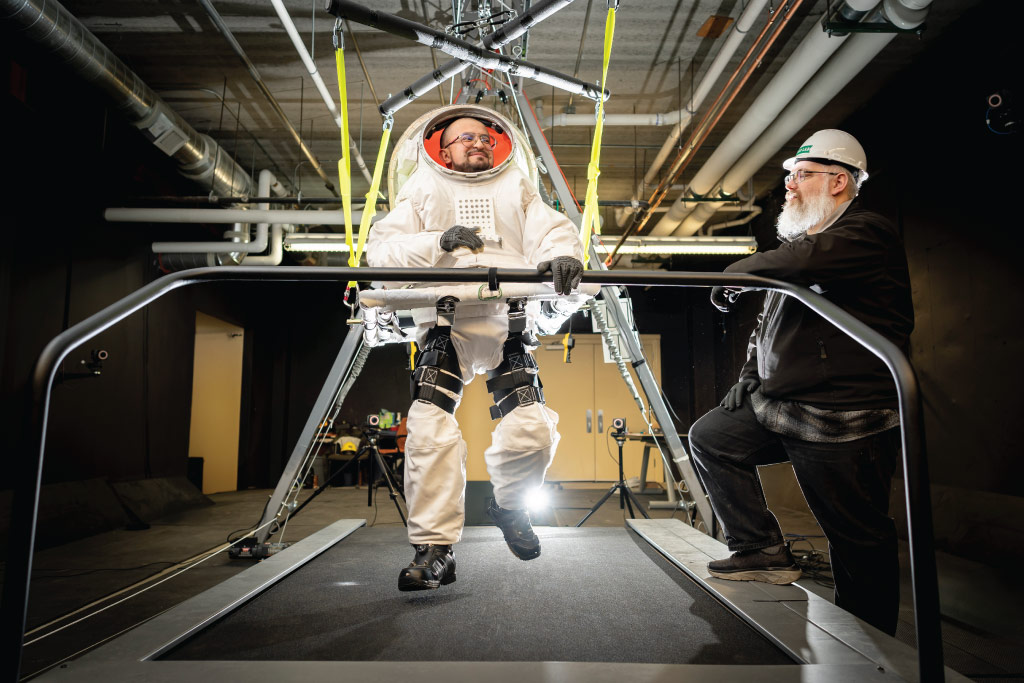
David Mateus tests simulated lunar gravity as Keith Crisman monitors his safety.
Third Stop: ILMAH
Living in Space (in North Dakota)
Before humans return to the Moon or reach Mars, they need to practice living in space-like
environments. UND has just the place.
Just west of campus near I-29, the Integrated Lunar/Mars Analog Habitat (ILMAH) looks like something out of a sci-fi movie: a cluster of white cylinders
connected by tunnels, with antennas poking skyward and a rover parked outside. Inside,
it feels like a miniature Moon or Mars base.
Since its first mission in 2013, this high-tech testbed has hosted students, NASA researchers, industry partners, and military personnel, all simulating life and work in this off-world environment.
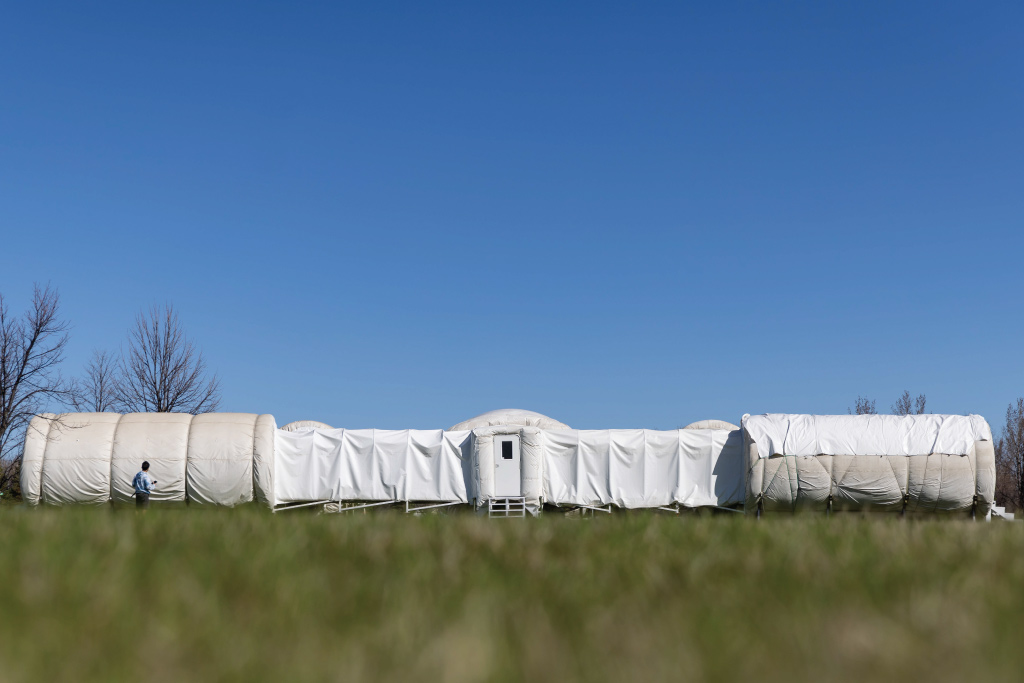
Integrated Lunar/Mars Analog Habitat (ILMAH)
Funded by NASA, ILMAH began as a single module with four bedrooms, a galley kitchen, dining area, bathroom, and a workstation. In 2015, it grew to include four more modules for growing plants, extravehicular activity, scientific workspace, and exercise.
“The fact that we can connect NASA with UND here in North Dakota, creating state-of-the-art research relevant to the future of humankind in space, is one of my biggest prides,” Pablo said.
We’re top three in the world for analog habitats. Students designed most of this. Space Studies made this happen, and it is world-class.Jurie Visage
Life Inside the Habitat
Ph.D. student Jurie Visage spent 21 days inside ILMAH, where crews face many of the same challenges as astronauts in space — including isolation, confinement, and limited resources.
Like a Mars mission, communication with the outside world was delayed by 20 minutes one way. Crew members each had a small private bedroom; an open door signaled they were open to interaction, while a closed one subtly asked for privacy.
The limited natural light disrupted circadian rhythms and made sleep difficult.
Most ILMAH missions last seven to 14 days. “Human psychology really comes into play at the 21-day mark,” Jurie said, emphasizing the importance of a well-connected crew. He added that crew members de-stress in different ways, including exercise. Gear on the ILMAH is similar exercise to the ISS, where astronauts exercise two hours a day to maintain bone and muscle mass.
Today, ILMAH is a globally recognized research facility that enables UND students and international collaborators to test long-duration space missions — without ever leaving North Dakota.
Fourth Stop: Planetary Science Lab
Growing Food on Mars
Suits, boots, and habitats might get astronauts to Mars — but they won’t keep them alive. For long-term missions, they’ll need to grow their own food.
“Finding ways to feed people on Mars is a pressing need for humanity,” said Sherry Fieber-Beyer, ’06, ’10, Associate Professor of Space Studies.
Sherry believes the answer lies in asteroids. Her vision? Capture them and use their rocky soil to grow crops on Mars.
But there’s a problem: Asteroid soil can’t retain water, making plant growth impossible. “The asteroid soil doesn’t have any microbes in it, so we have to make it,” she said.
To bring that rock to life, Sherry will start by planting a simple cover crop. She will slowly add nitrogen and encourage microbial growth through repeated planting and harvesting — essentially turning space rocks into real soil.
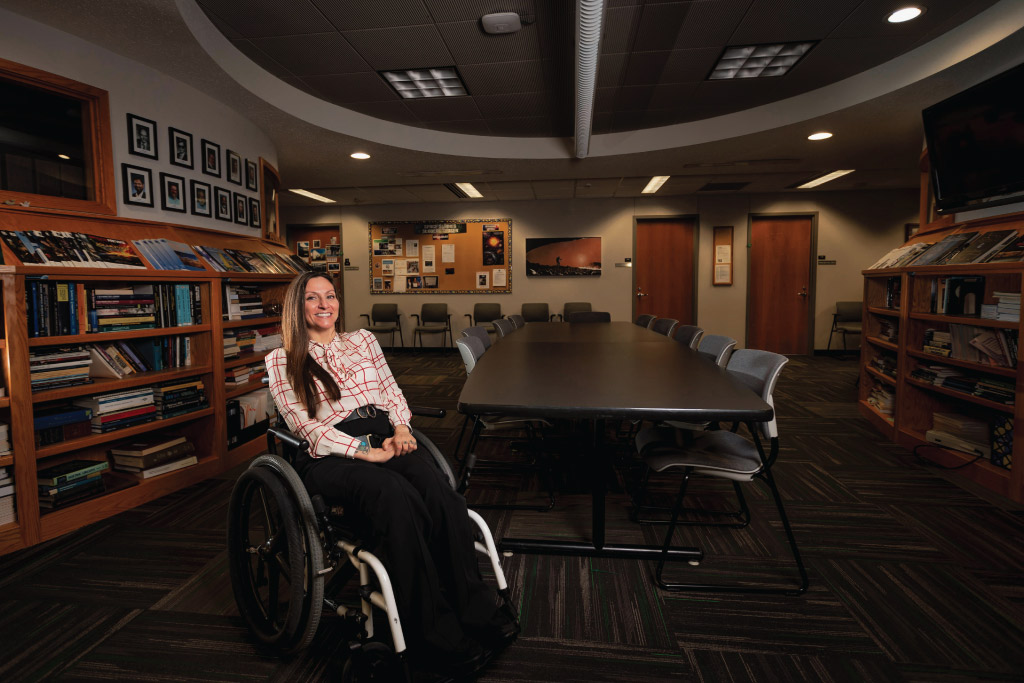
Sherry Fieber-Beyer works to turn space rock into usable soil.
Turning to the Three Sisters
Most space agriculture projects rely on high-tech systems like hydroponics and aeroponics, but Sherry is taking a path rooted in Indigenous history and tradition.
“By incorporating Native American agricultural practices, we can find a sustainable path forward,” she said.
With heirloom seeds from the Mandan, Hidatsa, and Arikara Nation, Sherry is growing corn, beans, and squash — known as the “Three Sisters.”
If successful, these time-tested companion crops could help sustain astronauts on Mars. She’s already tested them in her backyard. “If I can’t grow it in regular soil, I better not try growing it on an asteroid,” she said.
To Mars and Beyond
Farming on Mars will be essential. The trip is too long and energy-intensive to rely on food from Earth.
Sherry is seeking grants to support her work, which she sees as part of something much bigger. “The impact of this research goes beyond our lifetime, our grandchildren’s lifetime, and even our grandchildren’s children.”
Meanwhile, her background in researching asteroids continues to make her a sought-after
expert.
“Asteroids are harbingers of death and beacons of life,” she said. “They’re time capsules,
preserving the conditions of our solar system’s formation, its violent history, and
its ongoing evolution.”
If her experiments succeed, those “beacons of life” may become the key to growing life far beyond Earth.
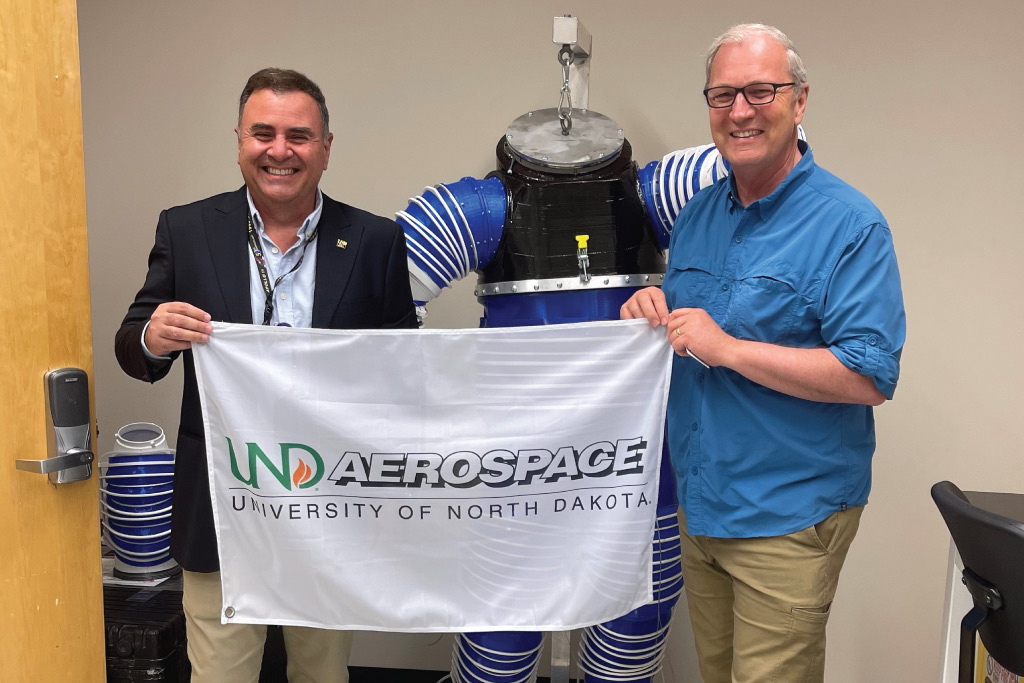
United State Senator Kevin Cramer (pictured with Pablo de León) is a strong proponent of UND’s space exploration and national security efforts.
Final Destination: The Future of Space Exploration
All ROADS Lead Here
Like charting a course to a new galaxy, what you’ve read here is only the beginning of the journey unfolding in UND’s Department of Space Studies.
Over the last three years, UND has seen unprecedented investment by the State of North Dakota and support from our federal delegation to make a deeper impact in space and national security.
This summer, the first satellites built in North Dakota will launch as part of the Rendezvous and Operations for Autonomous Docking and Servicing (ROADS) program. “We’re setting up a mission control center right here at UND — on the roof of Clifford Hall — to operate the satellites in space,” Pablo said.
The next launch, slated for November 2025, will feature satellites designed and built by UND students, some of whom study Aerospace Engineering, a degree program introduced in 2023 as a result of collaboration between the Odegard School of Aerospace Sciences and the College of Engineering & Mines. It’s the only aerospace engineering program in the Dakotas, Montana and Idaho — in other words, between Minneapolis and Seattle.
Follow the ROADS mission and discover more breakthroughs in the John D. Odegard School of Aerospace Sciences in their magazine, Aerocom.

